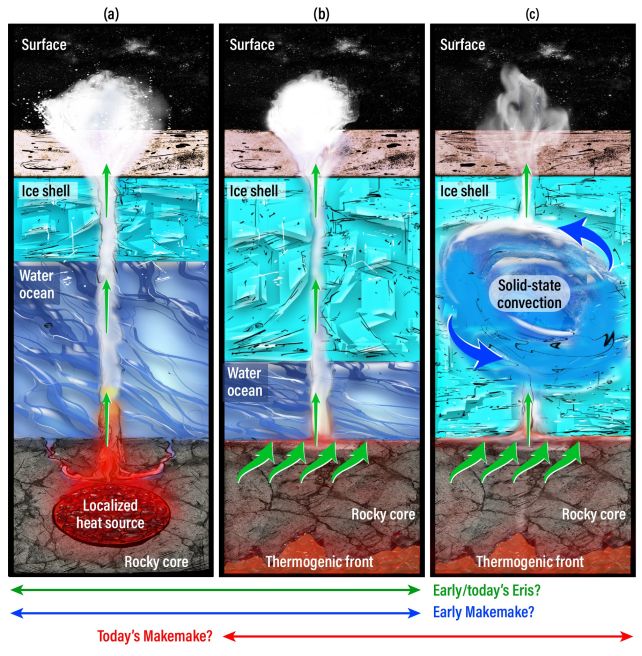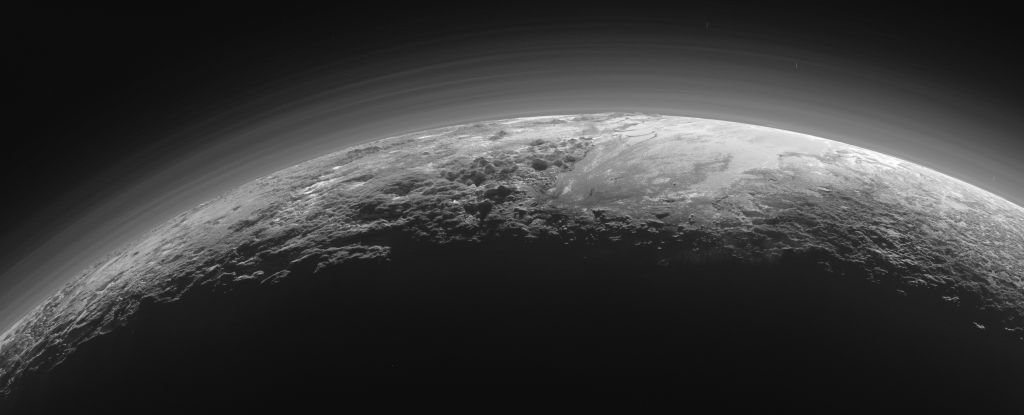The Solar System doesn’t get much colder than the Kuiper Belt.
Out past the orbit of Pluto, far from the warmth of the Sun, drifts a vast expanse of icy rocks and dwarf planets thought too cold to be little more than snowballs in outer space.
As the New Horizons data on Pluto showed, however, appearances may be deceptive. And now scientists have discovered that two other dwarf planets may be keeping secrets.
Eris and Makemake are dwarf planets that, like Pluto, hang out in the Kuiper Belt. And, also like Pluto, they have now been found to exhibit evidence of oceans sloshing about beneath their frozen crusts.
That evidence is lurking in methane frozen on the surfaces of the tiny distant worlds that has isotope ratios consistent with internal heating.
“We see some interesting signs of hot times in cool places,” says planetary geochemist Christopher Glein of the Southwest Research Institute in Texas.
“I came into this project thinking that large Kuiper Belt objects (KBOs) should have ancient surfaces populated by materials inherited from the primordial solar nebula, as their cold surfaces can preserve volatiles like methane. Instead, the James Webb Space Telescope (JWST) gave us a surprise! We found evidence pointing to thermal processes producing methane from within Eris and Makemake.”
Both Eris and Makemake are smaller and more distant than Pluto. Pluto has a radius of 1,188 kilometers (738 miles), and orbits the Sun at an average distance of 39 astronomical units.
Eris is just a smidge smaller, with a radius of 1,163 kilometers, but its average distance from the Sun is a whopping 68 astronomical units. Makemake orbits at an average of 45.8 astronomical units, but its radius is a teensy tiny 715 kilometers.
Even Pluto is hard to see, out there in the far reaches of the Solar System. Smaller, more distant worlds verge on the edge of invisibility. That’s why we needed to wait for an instrument as powerful as the JWST to learn more about them in detail.
It has been known for many years that the surfaces of these dwarf planets are dominated by methane ice. Because the Kuiper Belt is sitting so far away, scientists thought that the surfaces of both worlds were as pristine as they were thought to be frozen, unchanged since their formation some 4.5 billion years ago.
Using the JWST, astronomers took spectroscopic observations of both dwarf planets in reflected sunlight. This allowed them to measure the isotope ratios in methane – specifically, the ratios of deuterium, or heavy hydrogen, to normal hydrogen – known as the D/H ratio – as well as isotopes of carbon.
Both sets of ratios implied that the methane on the surfaces of Eris and Makemake is significantly younger than methane that would have been hanging about since the formation of the Solar System.
“The moderate D/H ratio we observed with JWST belies the presence of primordial methane on an ancient surface. Primordial methane would have a much higher D/H ratio,” Glein explains.
“Instead, the D/H ratio points to geochemical origins for methane produced in the deep interior. The D/H ratio is like a window. We can use it in a sense to peer into the subsurface. Our data suggest elevated temperatures in the rocky cores of these worlds so that methane can be cooked up. Molecular nitrogen (N2) could be produced as well, and we see it on Eris. Hot cores could also point to potential sources of liquid water beneath their icy surfaces.”

And the carbon isotope ratios agree.
“If Eris and Makemake hosted, or perhaps could still host warm, or even hot, geochemistry in their rocky cores, cryovolcanic processes could then deliver methane to the surfaces of these planets, perhaps in geologically recent times,” says astronomer Will Grundy of Lowell Observatory in Arizona. “We found a carbon isotope ratio (13C/12C) that suggests relatively recent resurfacing.”
These findings strongly suggest that we may need to rethink the dynamics of the outer Solar System. Scientists think conditions for microbial marine life might exist in subsurface oceans on otherwise frozen worlds, such as Saturn‘s moon Enceladus, and Jovian moon Europa, whose cores are thought to be hot enough to produce favorable conditions deep within.
If subsurface oceans can also exist in the Kuiper belt – and, in fact, are common – the outer Solar System might not be as hostile and inhospitable as we thought it was.
“After the New Horizons flyby of the Pluto system, and with this discovery, the Kuiper Belt is turning out to be much more alive in terms of hosting dynamic worlds than we would have imagined,” Glein says.
“It’s not too early to start thinking about sending a spacecraft to fly by another one of these bodies to place the JWST data into a geologic context. I believe that we will be stunned by the wonders that await!”
The findings have been published in two papers published in Icarus. They can be found here and here.





